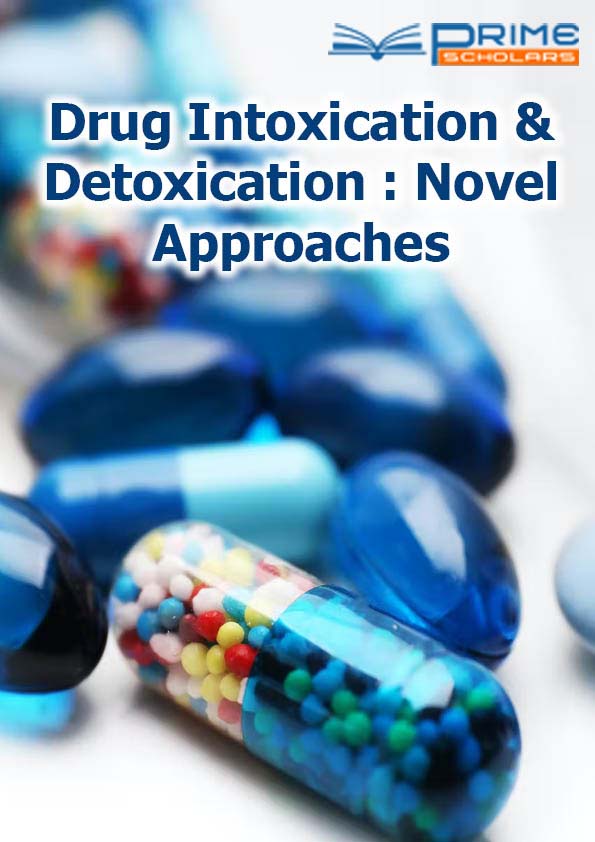Short Communication - (2022) Volume 3, Issue 3
Pharmacological Treatment for the Drug Addicted Individuals and their Studies
Burger Escobar*
Department of Chemotherapy, Universidade Federal de Santa Maria, Brazil
*Correspondence:
Burger Escobar,
Department of Chemotherapy, Universidade Federal de Santa Maria,
Brazil,
Email:
Received: 01-Aug-2022, Manuscript No. DIDNA-22-14865;
Editor assigned: 03-Aug-2022, Pre QC No. DIDNA-22-14865 (PQ);
Reviewed: 17-Aug-2022, QC No. DIDNA-22-14865;
Revised: 22-Aug-2022, Manuscript No. DIDNA-22-14865 (R);
Published:
29-Aug-2022, DOI: 10.36648/DIDNA 3.3.15
Introduction
Illegal drug use not only causes irreparable harm to individuals,
their families and society as a whole, but also causes enormous
damage to health. It is clear that current pharmacological
drugs are only palliative and fail to prevent the feared relapse.
This deficiency has stimulated research in our research facility,
particularly ebb and flow studies, as the method to our knowledge,
this is the primary study demonstrating beneficial TS-activated
neural adaptations in adult rodents after amphetamine
enslavement.
Description
We evaluated the effects of TS when applied to his AMPH backslide in adult rats, along with assessments of subatomic boundaries firmly associated with illicit drug use measured in the nucleus accumbens (NAc). The ratings were:
Drug propensity, withdrawal, and reinstatement as animals exhibited recurrent behavior. During AMPH withdrawal, the TS rule used in adult animals had the ability to prevent his AMPH relapse after drug resumption. The trial bundle showed no memory or motor deficits in the Y-maze task. AMPH increased her D1R, DAT, TH, ΔFosB, and MOR immune levels in NAc, whereas TS had the opportunity to decrease these atomic marker levels. Previous research by our laboratory substantiates his CPP worldview in exploratory practices related to AMPH enslavement, apart from other drugs such as cocaine and morphine. Thus, for example, post-medication stress or resumption of medication may restore dependence, which may be tentatively seen through the restoration of medication trends in the CPP worldview. Our ongoing findings indicate that to treat tolerance, AMPH-type organisms initiated the observed drug-relapse behavior via AMPH-CPP, and, as seen in CPP, AMPH confirms an association between the decadent effects induced by creatures that became adults during the TS treaty grace period showed no relapse after AMPH was resumed. Indeed, our previous studies have shown positive effects of neonatal TS against both AMPH and cocaine CPPs. Moreover, neonatal TS modulates adolescent behavior, reduces drug-induced social refinement, and reorganizes the psychiatric domain of chronic drug use. Nevertheless, ongoing results point to a TS technique in therapeutic architecture or, at least, it has been applied to adult organisms that have recently shown AMPHCPP whose behavior indicates habit. During the follow-up period, these animals received adult TS to prevent AMPH relapse behavior after drug resumption. As far as we are aware, only neonatal TS has been tentatively studied and applied clinically, so this finding is creative.
Nevertheless, writing information is sparse when TS is applied to adult organisms. In this particular situation, memory impairment can lead to inaccurate results. This is because the evaluation of memory is fundamental, as living organisms do not store data relating natural signs to free influences. In addition, the Y-maze task is ready to demonstrate locomotion performance in rodents, the deterioration of which can lead to misinterpretation [1-4].
Conclusion
In this sense, our results showed no significant differences in
memory and speed between experimental sessions, as currently
presented in the Bible. From this information, we conclude
that the point tilt seen in creatures after AMPH reopens
in the CPP worldview is directly related to the greedy effect
caused by AMPH, but not to deficits in movement or memory.
Despite the fact that AMPH exerts behavioral and psychiatric
effects by modulating the action of monoaminergic synapses,
it is unlikely that its supportive and euphoric effects are mediated
primarily by dopaminergic synapses.
Acknowledgement
None.
Conflict of Interest
The author’s declared that they have no conflict of interest.
REFERENCES
- Doran KM (2018) Substance use and homelessness among emergency department patients. Drug Alcohol Depend 188:328-333.
[Crossref] [Google Scholar]
- Gabriel KWL (2021) An inquiry into the relationship between drug users' psychological situations and their drug-taking behaviour. Int J Environ Res Public Health 18(23):12730.
[Crossref] [Google Scholar]
- Nancy AR, Gina RK (2022) Treatment of tobacco smoking: A review. JAMA 327(6):566-577.
[Crossref] [Google Scholar]
- Naomi G (2021) Association between use of pharmacokinetic-interacting drugs and effectiveness and safety of direct acting oral anticoagulants: Nested case-control study dematology. Clin Pharmacol Ther 110(6):1526-1536.
[Crossref] [Google Scholar]
Citation: Escobar B (2022) Pharmacological Treatment for the Drug Addicted Individuals and their Studies. Drug Intox Detox:
Novel Approaches. 3:15.
Copyright: © 2022 Escobar B. This is an open-access article distributed under the terms of the Creative Commons Attribution
License, which permits unrestricted use, distribution, and reproduction in any medium, provided the original author and source
are credited.
